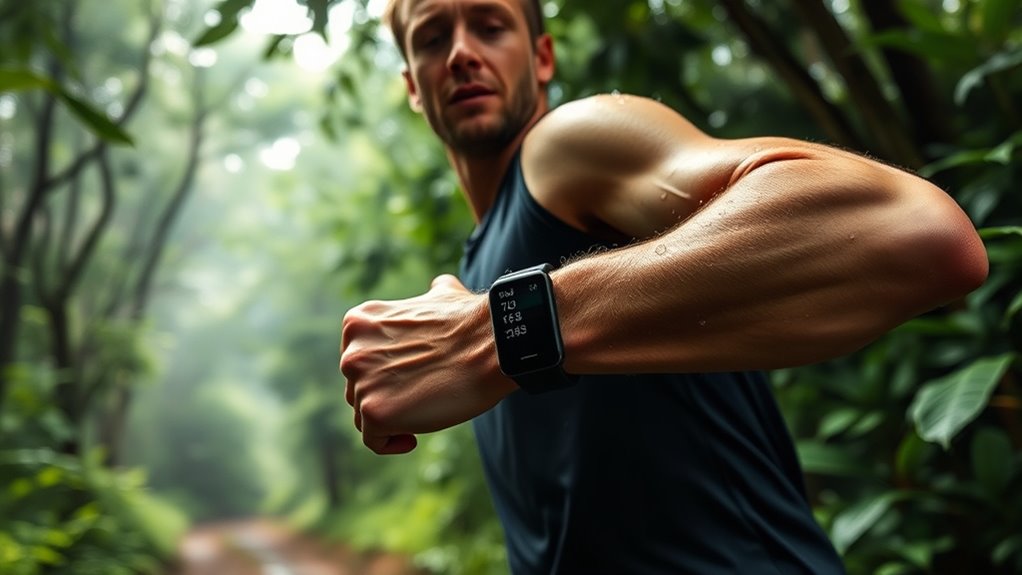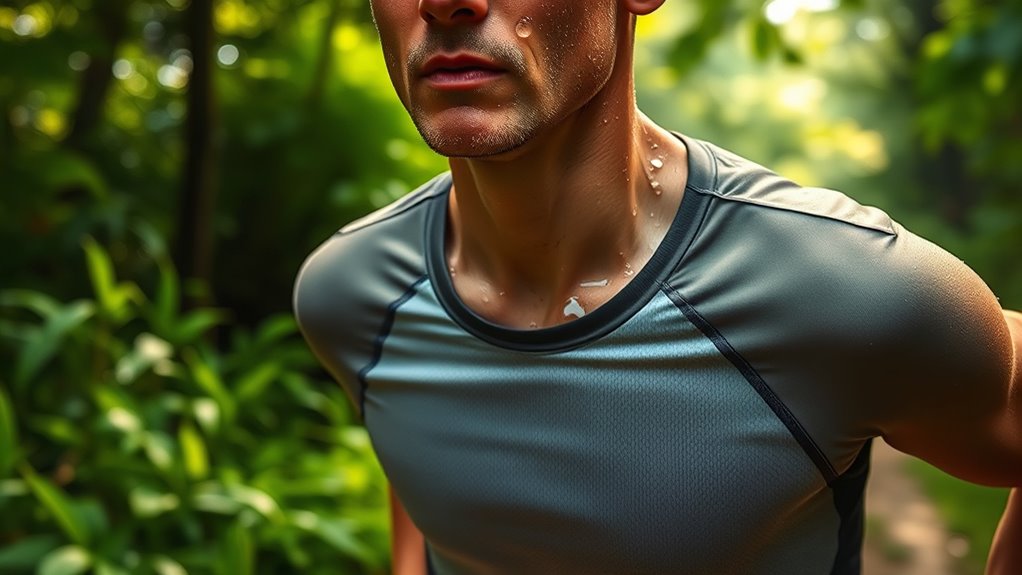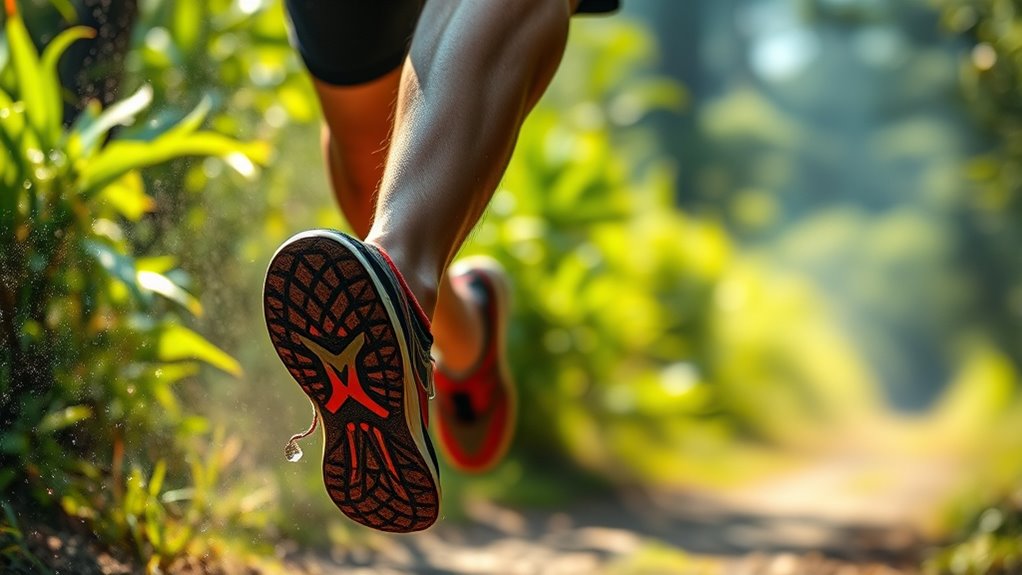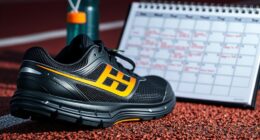Running in humidity hampers your body’s ability to cool through sweat evaporation, making it essential to accurately measure your sweat rate and stay properly hydrated. Weigh yourself before and after runs, tracking fluid intake to personalize your hydration plan. Wearing light, breathable clothing and scheduling runs during cooler times can help prevent overheating. Mastering these hacks ensures you stay safe and comfortable—continue exploring for more tips to beat humidity challenges effectively.
Key Takeaways
- Measure pre- and post-run weight, accounting for fluid intake, to accurately determine individual sweat rate.
- Hydrate consistently before, during, and after runs using electrolyte drinks to maintain balance and prevent dehydration.
- Run during cooler times of day and consider indoor treadmill options to reduce heat stress from high humidity.
- Wear lightweight, moisture-wicking, breathable clothing to enhance sweat evaporation and keep your body temperature regulated.
- Adjust pace and distance gradually as your acclimatization to humidity improves to optimize comfort and safety.
Understanding the Impact of Humidity on Your Body

When you run in humid conditions, your body faces additional challenges in regulating temperature. High humidity levels impair evaporative cooling, the process where sweat evaporates from your skin to lower your body temperature. When humidity is high, sweat doesn’t evaporate as efficiently, causing your core temperature to rise faster. The humidity index measures these conditions, indicating how much humidity hampers cooling. A higher humidity index means your body struggles more to dissipate heat, increasing your risk of overheating. As a result, you may feel more exhausted and experience faster dehydration. Your body’s ability to cool itself diminishes, making hydration strategies even more vital. Recent AI discoveries have also explored ways to optimize cooling strategies using technology. Understanding how humidity impacts your cooling mechanisms helps you adjust your pace and hydration strategies during outdoor runs, especially considering how projector technology can improve visibility in certain environments. Additionally, advancements in AI security have contributed to developing smarter monitoring tools that can alert runners to dangerous heat levels in real-time, enhancing safety.
How to Measure Your Sweat Rate Accurately

To measure your sweat rate accurately, you need to track how much fluid you lose during a run and how much you hydrate beforehand. Start by weighing yourself before and after your run, preferably nude or in similar clothing, to get precise measurements. Drink a known amount of fluid before starting, and account for any intake during the run. Many hydration myths suggest drinking excessively or avoiding fluids altogether, but understanding your sweat composition helps find the right balance. Remember, sweat isn’t just water; it contains electrolytes and other components, which vary between individuals. By carefully recording your fluid intake, weight differences, and run duration, you can determine an accurate sweat rate. This method ensures you’re not relying on inaccurate assumptions about hydration or sweat composition. Using proper measurement techniques can further improve the accuracy of your sweat rate calculations. Additionally, considering air quality during your run can help optimize your performance and recovery. Incorporating tuning principles from vehicle performance can also inspire personalized hydration strategies that match your unique physiology. Moreover, paying attention to dog names that reflect your personality might motivate you to stay consistent with your hydration routine.
Calculating Your Personal Sweat Loss During Runs

To figure out how much you sweat during a run, you can use the weigh-in method by measuring your weight before and after. Tracking your fluid intake helps refine the estimate, ensuring you account for what you drank. Combining these methods gives you a clear picture of your personal sweat loss in humid conditions. Being aware of your side effects of dehydration can help you better manage hydration needs during intense or prolonged exercise. Understanding your RMDs and how they impact your overall hydration plan can also be beneficial.
Weigh-In Method
Ever wonder how much water you lose during a run? The weigh-in method helps you find out by measuring your weight before and after. Since your metabolic rate and sweat gland activity vary, this method gives personalized insights into your sweat loss. To do it accurately:
- Weigh yourself nakedbefore your run.
- Run your usual distance and intensity.
- Weigh yourself again immediately afterward, in minimal clothing.
- Subtract your post-run weight from your pre-run weight to determine fluid loss.
Fluid Intake Tracking
Tracking your fluid intake during runs helps you understand how much water you need to stay properly hydrated. By monitoring sweat loss, you can estimate your personal sweat rate and adjust your fluid intake accordingly. Consider your sweat composition, which varies based on factors like humidity and temperature, affecting electrolyte balance. If you notice excessive saltiness or cramping, you might be losing more electrolytes than water. Recording your fluid consumption and weight loss after runs helps identify your ideal hydration plan. This way, you prevent dehydration or overhydration, both of which can impair performance. Consistently tracking your intake allows you to fine-tune your hydration strategy, ensuring your electrolyte balance remains best and your running feels easier, especially in humid conditions.
Hydration Strategies to Combat Excessive Sweating

When running in humid conditions, staying properly hydrated becomes essential to replace fluids lost through excessive sweating. To combat dehydration, focus on effective hydration strategies that support electrolyte replenishment and mineral absorption. Properly hydrated runners maintain energy and reduce cramping risks. Consider these tips:
In humid running conditions, stay hydrated with electrolyte drinks and small sips to prevent dehydration and cramps.
- Drink electrolyte-enhanced beverages to replenish essential minerals.
- Consume small, frequent sips instead of large gulps to optimize hydration.
- Incorporate foods rich in potassium and magnesium to aid mineral absorption.
- Use hydration packs or bottles for consistent fluid intake during runs.
Practical Hacks to Stay Cool and Prevent Overheating

To stay cool and prevent overheating, choose breathable clothing that allows airflow and sweat to evaporate. Make sure to hydrate well before your run to keep your body temperature regulated. Timing your runs during cooler parts of the day can also make a big difference in how comfortable you feel.
Wear Breathable Clothing
Wearing breathable clothing is essential when running in humid conditions, as it helps your body stay cool and reduces the risk of overheating. Opt for moisture wicking fabrics and breathable fabrics that allow sweat to evaporate quickly, keeping you dry and comfortable. Choosing the right gear can make a significant difference in your performance and comfort.
Consider these tips:
- Select lightweight, loose-fitting shirts made from moisture wicking fabrics.
- Wear shorts or leggings designed with breathable fabrics for enhanced airflow.
- Avoid heavy or cotton clothing that traps heat and moisture.
- Use hats or visors with breathable mesh to shield your face from the sun.
Hydrate Before Running
Staying well-hydrated before you start running is key to maintaining your body’s temperature and preventing overheating in humid conditions. Drinking water alone may not fully restore your electrolyte balance, so consider consuming pre run snacks that include electrolytes, like a banana with a pinch of salt or sports drinks. Proper hydration helps your body regulate temperature more effectively and reduces the risk of dehydration. Aim to hydrate gradually in the hours leading up to your run, rather than gulping large amounts at once. This ensures your stomach isn’t overwhelmed and your hydration levels are optimized. Keeping your electrolyte balance in check before running helps maintain stamina and prevents cramping, making your workout safer and more comfortable in high humidity.
Time Your Runs Wisely
Running during the hottest parts of the day can quickly lead to overheating, so scheduling your runs when the temperatures are lower is essential. Early mornings or late evenings are ideal, especially in humid conditions. For variation, try interval training during cooler hours to boost endurance without overexerting yourself. When deciding between outdoor vs indoor running, consider that outdoor runs expose you to humidity and heat, making timing even more critical. If outdoor conditions are too hot, switch to indoor running on a treadmill, where you can control the environment. Keep these hacks in mind:
- Run early or late in the day
- Use interval training to avoid long exposure
- Opt for indoor running during peak heat
- Adjust your schedule based on humidity levels
Clothing and Gear Tips for Humid Conditions

When running in humid conditions, choosing the right clothing and gear is essential to stay comfortable and prevent overheating. Opt for moisture-wicking fabrics that draw sweat away from your skin, helping you stay dry and cool. Lightweight, breathable materials reduce heat buildup and improve comfort during your run. Gear ventilation is also vital; select clothing with mesh panels or vents that promote airflow, allowing heat and moisture to escape. Avoid heavy or non-breathable fabrics, as they trap sweat and increase the risk of chafing. Consider wearing a lightweight, moisture-wicking hat or visor to shield your face from the sun. Proper gear not only improves comfort but also helps regulate your body temperature, making your runs in humidity safer and more enjoyable.
Adjusting Your Running Routine for Humidity Challenges

Adjusting your running routine is essential to handle the challenges posed by humidity. Humidity effects can cause quicker fatigue, dehydration, and overheating. To combat this, incorporate acclimatization techniques gradually, allowing your body to adapt to higher moisture levels.
Here are some tips to optimize your runs:
- Run during cooler times of day, like early mornings or evenings
- Shorten your distance or pace until your body adjusts
- Increase hydration before, during, and after your run
- Wear lightweight, breathable clothing to help sweat evaporate efficiently
Frequently Asked Questions
How Does Humidity Affect Electrolyte Balance During Runs?
Humidity impacts your electrolyte balance by making sweat gland efficiency less effective, causing you to sweat more. As you sweat more, you’re at higher risk of electrolyte imbalance, which can lead to cramps and fatigue. You might not notice how much electrolytes you’re losing, so it is crucial to replenish them during your run. Keep an eye on hydration and electrolyte intake to maintain balance and avoid dehydration and related issues.
Can Certain Foods Improve Sweat Efficiency in Humid Conditions?
Certain foods can help improve sweat efficiency in humid conditions through proper hydration strategies and dietary adjustments. Eating potassium-rich foods like bananas, sweet potatoes, and spinach supports electrolyte balance, reducing dehydration risk. Incorporate hydrating fruits such as watermelon and oranges to boost fluid intake. These dietary choices enhance your body’s ability to regulate temperature and sweat effectively, making your runs in humidity more comfortable and reducing fatigue.
What Are Signs of Dehydration Specific to Humid Environments?
In humid environments, you’ll notice signs of dehydration like dry mouth, dizziness, and dark urine. To combat these, prioritize hydration strategies like drinking water regularly and replenishing electrolytes. Choose lightweight, moisture-wicking clothing to stay cool and reduce sweat loss. Pay attention to your body’s signals, and don’t wait until you’re thirsty—stay proactive with your hydration and clothing choices to stay safe and comfortable while running.
How Does Humidity Impact Recovery After Running?
Humidity slows your recovery by impairing your body’s ability to cool down. You may feel more fatigued and experience lingering soreness. To speed recovery, focus on hydration strategies that replenish lost fluids and electrolytes. Incorporate cooling techniques like ice packs or cold showers to reduce core temperature. Staying proactive helps your body recover faster, so listen to your signals and prioritize proper hydration and cooling after your runs.
Are There Specific Supplements That Help Manage Humidity-Related Sweat Loss?
You might consider supplements like electrolytes and hydration aids to manage humidity-related sweat loss. Staying properly hydrated through hydration strategies helps replenish lost salts and fluids. Cooling techniques, such as wearing moisture-wicking clothing or using ice packs, can also assist in maintaining your body temperature. These approaches work together to keep you hydrated and comfortable, ensuring you perform better and recover faster despite the humidity.
Conclusion
Think sweating more in humidity means you’re losing more water? Not necessarily. Your body adjusts, and your sweat rate doesn’t always increase proportionally. Instead, you might feel like you’re overhydrating or underperforming. The key is understanding your personal sweat rate and adjusting your hydration accordingly. By staying cool, wearing the right gear, and listening to your body, you’ll improve your runs and stay safe—even in the most humid conditions.









